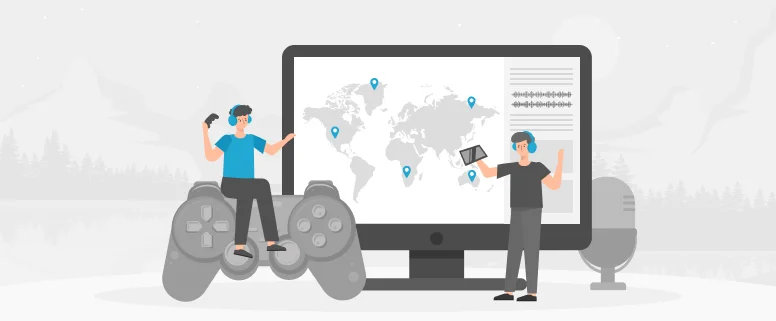Video game is a rapidly evolving industry. Every day brings something new for gaming enthusiasts. It has never always been the same. The industry has gained popularity over the past few decades. Today, the video game industry is surpassing the revenues of other sectors.
According to the latest Statista report, the video game market is projected to reach a revenue of $282.30 billion in 2024. The industry is expected to grow and reach a revenue of $363.20 billion by 2027, with an annual growth rate of 8.76%.
Moreover, the number of gamers is also increasing worldwide. According to a report, the number of gamers worldwide is expected to reach 3.320 billion by the end of 2024. The reason behind this exceptional growth is the availability of smart devices and easy access to multilingual games through online platforms.
Do you know that almost 64% of the traffic on the top 50 gaming websites comes from different countries? Even most of the gaming companies renowned as global brands are based in Asian countries, including China, Singapore, South Korea, and Japan.
The reason behind their success in the global market is video game localization services. This is the secret ingredient that plays a crucial role in the global success of any game. Today, we are here to give you a disclosure of everything you should know about game localization.
So, if you are a developer or a gaming company, this article is going to help you create an effective game localization strategy that will enhance your appearance in the highly saturated international marketplace. But, for that, you need to read this article carefully.
What is Game Localization?
For a better understanding of game localization, you need to understand the game development process first. It is not like what you think, where developers just get their hands on the keyboards, type codes, create a program, and run it. It is a thorough process that includes brainstorming the idea of the game and its relevance to the target market.
This is where game localization comes in. It is the process of adapting your game to resonate with the target audience’s local preferences. A successful game with which the users can easily interact requires the linguistic and cultural connectivity of the players with the game.
The process is done by translators. They are not just translators but professionals with years of hands-on experience and expertise in game localization. They make sure that your game doesn’t contain any offensive or abstract content that is against the player’s beliefs.
For example, while developing a game for the Chinese market, you cannot use props like skulls, or bones. Chinese like bright colors, aesthetic scenery, and traditional props. Whereas, if you are targeting US audiences, you can go with a dark theme and rigid actions.
Localization is a complex process usually based on three steps, as follows:
- Translation
The first step in game localization is translation. It is the conversion of gaming content, including the app description, title, character names, and in-game descriptions, from the source language to the target language. Keep in mind that this translation is way different than the typical translation process and done by a professional game translation company such as CCJK. This includes the conversion of languages while preserving the original meaning and essence of the source language.
For example, if a Chinese company creates a game for a US audience, the language will be English, but the concentration of the game will be according to the Chinese methodology.
- Transcreation
This is the second step, where professionals showcase their creative skills and transcreate the game content to adapt it exactly according to the target audience. For example, the idiomatic expressions and references that are used in a Chinese game might not sound relevant to the US or Japanese audience.
This irrelevancy can damage the game’s position as well as the company’s name in the global market. Therefore, to save you time, transcreation services are available. They make sure that the idiomatic expressions, puns, humor, and social references used in the game are linked to the target users.
- Testing
The third process is testing. This is like the final stage for confirmation that you are following the right path. It includes testing the localized version of the game. For that, companies pick random gamers from the local market and ask them to try the game and give their feedback.
This helps in finding out if there are any loopholes in the development or localization. With testing, companies provide a flawless and perfect version of their game that enhances its success rate as a global game.
What Video Game Elements Need Localization?
According to research, players give importance to the games that are available in their local language. It means that every element of the game should be localized according to the user’s linguistic and cultural preferences.
However, localizing a video game is a complex process that requires great expertise and experience. It includes handling the technical components of a game. So, it is crucial to understand the distinct demands and preferences for successful global reach. So, without any further ado, let’s take a look at the gaming elements that require professional localization:
- App Description
Users always prefer to take a look at the game before installing it. They read the description to find out the game’s storyline, features, and other elements. But what if the app description isn’t available in their local language? Do you think they would hit the install button? Never.
App description localization ensures that players get a clear view of the game’s features and why they should install it. So, adapt the description, get more downloads, and ultimately you will receive a high return on investment.
- User Interface
Do you know that most people notice the user interface of any application through the pictures attached along with the app description in the Play store? If they don’t like the sample, they don’t even bother to install the game. And if some install it and do not find the UI according to their expectations, they uninstall the game.
So, it is crucial to make the game’s user interface interactive. If it’s not, users will simply neglect it. Localization ensures that players like the game’s UI and remain engaged in the game.
- Keywords
Keywords are like navigators that help your audience find and choose you among a lot of other options. So, optimize the keywords in the target region’s local language. This enhances your approach and improves your game ranking in multiple regions you want to operate in.
- Storyline
The storyline shows the developer’s narrative to the player. It should be smooth and flawless. Whether you want to localize the game step-by-step or plot-wise, you can decide it considering its genre and type. Localization enhances the user experience for multilingual players, making the storyline easily accessible and understandable.
- Character Names
Personalization improves the gaming experience and helps players develop a unique profile setting. Localizing character names helps players choose and rename their profiles after their favorite players.
- Locations and Visuals
It can be challenging to remember the locations and complex terms in another language. Localization helps players easily understand the location names and also remember the visuals.
- Captions
Captions or in-game descriptions are important to help players easily navigate the gameplay and let them know what to do next. If they don’t understand it, there is a huge possibility they will lose interest in your game and stop playing it. This will KO your future in the gaming industry. Scary, right?
Why Localize Your Video Games?
Once again, game localization is a complex task that requires time, money, and resources. And we are sure, you don’t want to risk any of them. So, let’s encourage you by taking a look at the reasons why you should localize your video game for a new market.
- Brand Recognition
A typical strategy might help you find success in your local market. But, my friend, this is not going to work with globalization. So, for your brand to be recognized in the international marketplace and known by a global audience, you need localization. It helps you survive in the highly saturated global gaming market.
By localizing your game, you can grab the attention of an audience looking for a freshly launched game with innovative ideas that is especially available in their native language. Also, you can fulfill diverse requirements and demands that have a positive impact on your brand’s position.
- Increased Revenue
Well, you can’t deny it because ROI is the ultimate reason behind every launch. For increased revenue, nothing can be a better option than stepping into the global market. But it can be risk-taking with a whole new product, right? Wrong!
Localization is a one-time process unless you are updating your game frequently. This way, your investment will pay you back in the long run. So, with localization, you can eliminate the chances of loss and even get a high return on your investment for a long time.
- Positive Reviews
When players experience a game in their native language with cultural references they understand, they are more likely to leave positive reviews and recommendations. As a result, your game’s visibility boosts significantly and attracts more players.
Other than that, localization offers various benefits, such as enhancing player engagement, improving customer satisfaction, and helping you stay competitive in the global market.
What are the Latest Game Localization Trends?
Gaming is a rapidly evolving industry. The technological advancement in this field gives gaming companies leverage to extend their limits and create exceptional gaming content for enthusiasts. In recent years, the gaming industry has seen a significant rise. Therefore, it is crucial to stay aware of the latest localization trends in the gaming industry:
- AI and Big Data for Game Development
Artificial intelligence has no doubt clouded almost every industry, and gaming is no exception. Whether we want to create content or need ideas for new projects, we head towards AI. Using machine-learning algorithms, gaming companies are now extending their reach to more complex games and developing more dynamic ones.
These algorithms, also known as big data, are designed to analyze the gamer’s behavior and personalize their game accordingly. It helps adapt the game perfectly and makes it more engaging for players.
- Cloud Gaming for Everyone
You might be aware of the term cloud. Yes, it is just like the iCloud option we use on iPhones. It is actually the idea of connecting people by allowing them access to the same database. Today, the gaming world is shifting from basic to cloud platforms, allowing players to easily connect and strategize their gameplay.
The two most prominent examples of cloud gaming services are Luna and Stadia. This technology allows developers to target previously unreachable markets with less powerful devices by eliminating geographical limitations on hardware.
Localization for cloud gaming needs to consider factors like bandwidth limitations and latency for optimal streaming performance across diverse regions.
- Quality Assurance in Game Development
Gaming is a competitive industry. Therefore, to increase their survival chances, developers should focus on quality assurance. Localization from a professional translation company ensures a smooth and culturally appropriate experience for global audiences.
The quality assurance process is rigorous and based on high standards. It includes testing localized text, cultural references, voice acting, and identifying glitches and bugs that might arise during localization.
However, it is crucial to prioritize quality assurance early on, as it assists developers in saving their time and resources while delivering a high-quality final product.
In-Game Economies and Digital Assets for Global Markets
Virtual items like in-game currencies and digital assets fall into the category of monetization strategies that require careful consideration during localization. Notably, cultural preferences for specific items, pricing models, and legal regulations around digital assets may vary across regions.
Game localization needs to adapt in-game virtual items to ensure an engaging experience for international gamers. This includes offering culturally relevant item sets, adjusting pricing structures, and adhering to local laws concerning virtual goods.
Create a Rigorous Game Localization Strategy
Localization is a complex process, and it requires you to invest a good amount so that you can get a high return on your investment. However, making the wrong decision can spoil everything within a few seconds. To make sure that your localization strategy fits your needs and requirements, you need to do a little homework. The task is easy; all you need to do is follow these simple steps and create a rigorous localization strategy for your global game.
- Choose the Target Market
You cannot create a strategy until you are completely aware of your audience. So, the first step is choosing your target audience. For that, you need to analyze demographics, gaming trends, language preferences, cultural nuances, and regulations.
Other factors that you need to consider include market size, compatibility, and the growth potential of specific game genres and themes. When you find a fit in your market, prioritize a small start. Do not overextend yourself initially. Choose one or two high-potential markets, focus on providing the best gaming experiences, create a positive brand image, and then move on to other markets.
- Define Your Localization Goals
Increased sales and a high ROI (return on investment) are the ultimate goals of any business. But it should not be your only goal. Make sure to deliver an immersive and culturally appropriate experience for global audiences.
While entering a new market, your goal should be to build strong brand recognition and establish a positive reputation in new territories.
- Choose the Best Way to Localize Your Game
Localization is a complex process that only professionals with years of experience and subject-matter expertise can handle. As your goal is to provide a linguistically and culturally appropriate gaming experience to your audience, you can’t rely on low-experience translators.
Partner with a certified team equipped with language expertise and cultural understanding. The best practice is to build an in-house team based on developers and cultural specialists.
- Start Early with Your Game Localization
One common mistake that most gaming companies make is to keep localization at the end of the development process. It requires extra time and resources. You can save time by localizing for each region separately by starting localizing your game in the early development stages.
Design your game’s code and assets to be easily adaptable to different languages and cultural preferences. Moreover, create style guides, comprehensive glossaries, and context information for translators. It will help them to extract all in-game text from the code for efficient translation and future updates.
- Track Your Success
After putting so much effort and resources into localization, you won’t want to leave your game unattended, right? So, implement rigorous quality assurance testing to ensure language accuracy, cultural appropriateness, and functionality of localized content.
Player feedback is the best way to assess the localization quality and in-game experiences. You can hire some locals to test the game before officially launching it on the global market. It helps you find loopholes and shortcomings, if there are any.
Get Your Game Ready to Rock in a New Market!
So, your game is prepared for global dominance with a rigorous game localization strategy! Now, you can unleash your masterpiece on the global stage. With a deep focus on target audiences and markets, clear goals, and perfect execution, you’ve ensured your game resonates with the linguistic and cultural preferences of diverse audiences. Remember, localization is an ongoing journey. Therefore, keep refining your approach based on player feedback and evolving trends. Good luck!



